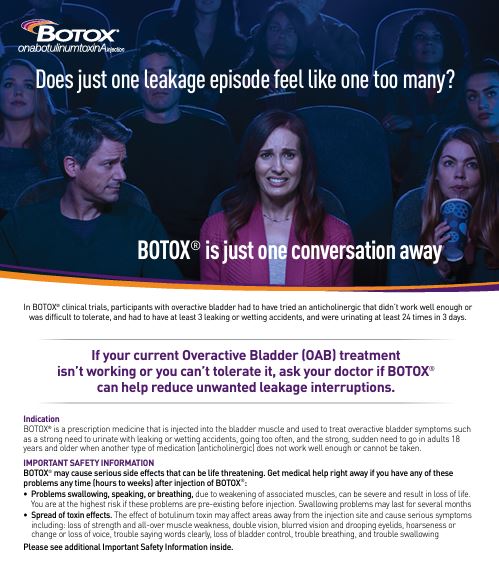Overactive Bladder
Overactive Bladder (OAB)
Overactive Bladder (OAB) is a problem with the bladder-storage function that causes a sudden urge to urinate. The urge may be difficult to stop, and an overactive bladder may lead to the involuntary loss of urine (urge incontinence). It can be the result of a number of conditions:
- Aging
- Bladder obstruction (see BPH and Urethral Strictures)
- Chronic inflammation or infection of the bladder or surrounding organs (bowel, uretus, ovaries)
- Neurologic conditions
- Bladder tumors
- Bladder stones

Symptoms
Four symptoms of OAB, which may occur on a daily basis or may come and go unpredictably:
- Urgency: a sudden and overwhelming urge to urinate immediately
- Frequency: urinating more than 8 times a day (Note: normal is about 4-6 times per day or every 3 to 5 hours, depending on fluid intake)
- Urge Incontinence: wetting accidents that follow a sudden urge
- Nocturia: waking 2 or more times during the night to urinate (Note: most people can sleep for 6 to 8 hours without having to urinate)
Diagnosis & Treatment
To choose the proper treatment, the underlying cause will need to be identified. Diagnosis includes:
- a thorough history and physical exam
- urinalysis
- Bladder Diary ( a journal kept by the patient over several days documenting the amount of fluid consumed, the number of trips to the bathroom, and the amount of urine output)
- possible radiologic studies such as ultrasound or CT scan
- possible testing of bladder nerves (Urodynamics)
- possible cystoscopy (a procedure that allows the physician to see inside the bladder)
Treatment may include:
- behavioral changes
- dietary changes
- medications
- Botox injections into the bladder
- bladder “pacemakers” (Sacral Nerve Stimulation)
Working With Your Medical Professional Team
Your medical professionals at Urology Associates P.C., work together as a team to help you manage your OAB symptoms, and are eager to help you. A few tips to receive the best treatment for you include seeing one of our urologists, physician assistants, or nurse practitioners to diagnose and treat your condition. Also, follow up with your OAB Nurse Navigator to receive coaching throughout your journey to improved bladder health.
